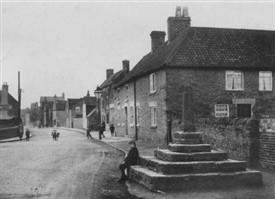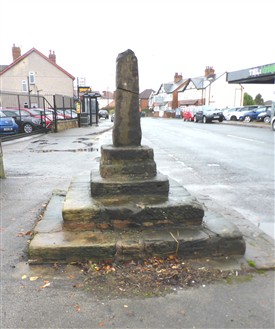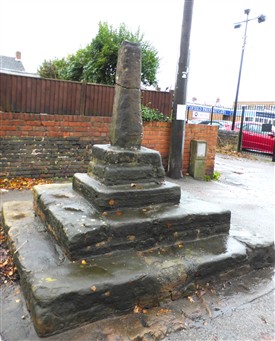Kirkby Cross

Kirkby Cross - Chapel Street is on the left

Kirkby Cross today
Photo Nov 2016 by Marg Thorne

Kirkby Cross today
Photo Nov 2016 by Marg Thorne
A Listed monument
By Marg Thorne
The listing for Kirkby Cross says that it is a C14th village cross. It was first listed on 28th November 1950.
A Grade II scheduled monument. The "market cross" was added to the scheduled monuments list on 12th September 1995.
The listing states
"The monument includes the remains of a market cross, Listed Grade II, located at the junction of Church Street, Chapel Street and Sutton Road. The remains comprise a short calvary or base of four steps surmounted by a socket stone and the lower portion of a cross shaft. The shaft would originally have been approximately twice its present height and would have included a carved cross head. These components are now missing, possibly due to religious iconoclasm in the 16th or 17th centuries. The bottom step of the calvary is c.2m square and is partially buried beneath the asphalt surface of the modern pavement. Each of the three lower steps is constructed of a double layer of pavings while the fourth step, measuring c.60cm square is a single block. The visible height of the calvary is c.0.75m. The socket stone or socle is c.40cm square and c.30cm high. It has chamfered corners and a stepped profile and appears also to be constructed of more than one piece of stone. The shaft fragment above is c.1m high, of tapering rectangular section and has been broken and repaired. The edges are chamfered and widen out into a rounded, cushion-like pedestal at the base. At the top, it ends in a rounded shoulder from which the rest of the shaft then rose. The broken stump of the missing section can still be seen and shows it to have been integral with the lower portion. The missing section was clearly much narrower than the shaft below, measuring c.15cm x 10cm rather than c.25cm x 20cm. It appears to have been ovoid in section and probably rose to an integral cross head. The precise date of the cross is not known but the right to hold a market in Kirkby in Ashfield was granted in the reign of Henry III (1216-1272). The surface of the surrounding pavement is excluded from the scheduling though the ground underneath is included."
In "The crosses of Nottinghamshire ", Stapleton refers to the small cross situate upon the high road which comes from Bollesovr (Bolsover).
According to Stapleton,A The crosses of Nottinghamshire [1891]; A catalogue of Nottingham Crosses [1912]
"Robert, son of John de Stuteville, had a grant of market and fair and free warren at Kirkby in 45th Henry III., (1260-1), so that there may have been an early market cross at Kirkby. Whether the existing Kirkby cross in the street, was associated with such a market, we cannot say. It is a fair average specimen of a plain unpretentious village cross, consisting of a complete shaft (of course headless) and a square base of four steps and a plinth. The base measures about eight feet in width and about three and a half feet in height… The fourth step appears to be one stone, and the plinth is in two stages. The shaft of a square form, but bevelled off somewhat at the angles, is about one foot in diameter at the bottom, tapering to about eight inches. Where the bevelling commences, at the height of a few inches, the whole stone is slightly cut away or reduced in diameter. The shaft, which apparently has not been curtailed, like the predecessor, was clearly a small cross, as it was only about four feet in height. The last few inches at the top have been cut down in the form of a neck, no doubt for fixing into the capital, of which with the surmounting cross it has been deprived. The stones of the base are held together by iron clamps, and the structure probably antedates those at Linby. At the foot of Kirkby Cross, but detached from it, stands a rough and battered flat stone, about three feet in height, fixed in the ground, and presenting almost the appearance of a tombstone without an inscription. Whether this be an old boundary mark, or what, we cannot tell. Whatever be the historic association of this cross, it has at least figured as a “preaching cross” In modern times, its steps being utilised by local dissenters."
In 2017,
The height of the shaft is 3ft 4” (c 1m) and very loose at the base. It bevels out at the bottom. The crack in the shaft is approximately 2ft 1” (63cm) from the bottom of the shaft on one side slanted to 1ft 10” (55cm) on opposite side. The edges on the top stone being chamfered, and rounded on 2nd stone. It looks like it has been in two at some point in its life. The diameter of the bottom stone is 6ft 4” by 7ft. (1.93m x 2.13m) The step height varying between 4” (10cm) and 6” (15cm) high probably caused by weathering. The top of the stone being between 10.5" (26cm) – 1ft (30cm) across. The second stone from the bottom has a diameter of 4ft 4” (1.32m) x 5ft 1.5 (1.56m)". The height of the step is 10"(25cm), and 10.5 (26cm)" – 1ft 3"(38cm) across the top of the stone. The third stone from the bottom has a diameter of 2ft 7"(78cm) x 2ft 8"(81cm), with the top of the step being between 3"(7cm) and 5"(12cm) wide. The top stone has a diameter of 1ft 9"(53cm) square, with the step being 12”(30cm) in height. It is 4” (10cm)to 5”(12cm) across the top, with approximately 1”(2cm) concrete infill to plinth. The infill is very evident.
The cross was demolished in 1975-6, and became subject of a campaign by the local newspaper to see it it should be moved. In 1987, it was again wrecked by a lorry.
The whole of the area was designated a conservation area in 1975.